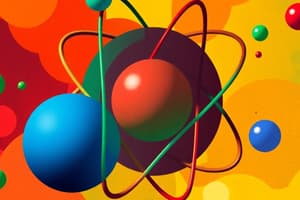Podcast
Questions and Answers
Which scientist proposed the first atomic theory?
Which scientist proposed the first atomic theory?
- Niels Bohr
- Democritus (correct)
- J.J. Thomson
- Erwin Schrödinger
What is the charge of an anion?
What is the charge of an anion?
- Positive charge
- Negative charge (correct)
- Neutral charge
- Variable charge
Which particle is located in the nucleus of an atom?
Which particle is located in the nucleus of an atom?
- Neutron (correct)
- Positron
- Electron
- Quark
Which model describes electrons as being in fixed orbits around the nucleus?
Which model describes electrons as being in fixed orbits around the nucleus?
What experiment led to the discovery of the nucleus?
What experiment led to the discovery of the nucleus?
Who is credited with quantifying the charge and mass of the electron?
Who is credited with quantifying the charge and mass of the electron?
Which of the following statements about neutrons is correct?
Which of the following statements about neutrons is correct?
Flashcards are hidden until you start studying
Study Notes
Atomic Theory
- Atoms are the smallest unit of matter.
- Everything is made up of atoms.
Atomic Model Evolution
- Dalton's Atomic Theory (1803) described atoms as solid spheres, like billiard balls.
- Thomson's Plum Pudding Model (1904) proposed a sphere of positive charge with electrons embedded within.
- Rutherford's Nuclear Model (1911) discovered the nucleus, a dense, positively charged center of the atom.
- The Cathode Ray Tube Experiment led to the discovery of electrons.
- Robert Millikan's Oil Drop Experiment measured the charge and mass of an electron.
- Eugene Goldstein discovered protons.
- Chadwick discovered neutrons.
- Niels Bohr's Planetary Model depicted electrons orbiting the nucleus in specific energy levels.
- Erwin Schrӧdinger's Quantum Theory proposed the orbital model, with electrons existing in probability clouds.
Subatomic Particles
- Protons are located inside the nucleus and determine the atom's atomic number.
- Electrons are located in a cloud surrounding the nucleus and contribute to the atom's overall charge.
- Neutrons are located inside the nucleus and have a mass similar to protons.
Important Concepts
- Anions are negatively charged ions.
- Cations are positively charged ions.
- The mole is a unit of measurement used in chemistry to represent the amount of a substance.
- Isotopes are atoms of the same element that have the same number of protons but a different number of neutrons.
- Atomic mass number is a rounded estimate of the combined number of protons and neutrons in an atom.
Studying That Suits You
Use AI to generate personalized quizzes and flashcards to suit your learning preferences.




